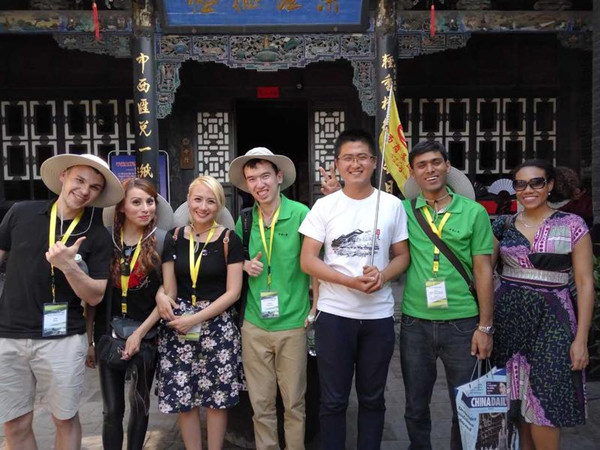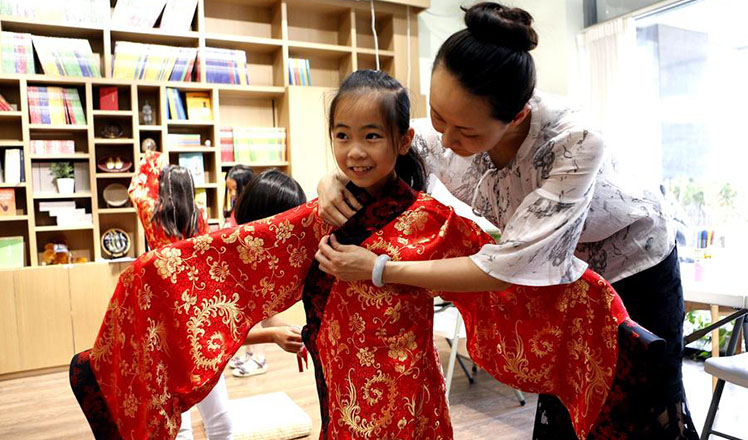Shanxi: Land of ancient splendor
Updated: 2016-07-08 16:22
By Jazmin Chi(chinadaily.com.cn)
|
||||||||
 |
|
Tourists take a photo in front of a sightseeing spot in north China's Shanxi province. [Photo provided to Chinadaily.com.cn] |
Let's set ourselves in Shanxi Province in the northern part of the country and go through some of the wondrous sightseeing spots this province has to offer. We'll also look at the influences in this charming land and the people who offer a lifetime of memories.
It's a land of striking sites, including underground tunnels built to protect a village in times of war with the capacity to shelter a whole settlement, as in the fortified town of Zhangbi in the heart of the province, to outstanding buildings at the top of remote mountains like Mianshan Mountain in Jiexiu county. These mountain homes and temples seem to defy gravity as they hug the ledges and rocky outcroppings of these majestic peaks.
In China doing one's best with a thought for future generations has been ingrained in families for centuries. An example can be clearly seen in the Wang family's courtyard home in Lingshi County, built during the Ming and Qing dynasties.
An ancestor in the tofu business invested his life in building the best business possible to leave to the next generation. Upward mobility was achieved through success in the tofu business, and eventually lead descendents to positions as government officials. Values and the arts were taught to children, which guaranteed they would be able to carry on with the responsibilities that great power entailed. Seventeen prosperous and virtuous generations lived in that traditional style courtyard estate, with two big palaces that showcased the family’s glory and hopes for future offspring.
Similar glory can be seen in the Qiao family courtyard compound in Qi county, captured on film in Raise the Red Lantern by director Zhang Yimou. The beauty and magnificence of the details in the compound transport us to the 1920s Warlord Era.
Next we go to Pingyao City, named by UNESCO World Heritage as the best preserved ancient city in China. Walking here is like walking in the last century in the latter part of the Qing Dynasty: there are big stone walls and streets that bring to mind a picture of qipao-clad women of that long ago era.
A visitor can eat distinctive Shanxi noodles with fountains of bittersweet vinegar and see a show where the noodles are stretched as thin as hair or the noodle dough is blown into big balls. There is the opportunity to sleep in a traditional courtyard home that gives the sensation of being completely immersed in the ancient, mystical flavor of this culture. This town has everything to experience traditional China.
It is also impressive to see how whole cities were transformed to become economic hubs in their times, such as the town of Qikou. There, one can see that due to its location on the banks of the Yellow River, the city emerged to become one of the main routes for economic development. When we walk through the city's streets, we can touch history and feel it deeply within ourselves. A visitor can imagine the last century, as posters remain, reflect the values of many decades ago and invite us to sample a bit of that era. Qikou offered glimpse of history and an eye-opening experience to the wonders of the ancient world.
In rich contrast to ancient China, Taiyuan City, the province's capital, is a thriving, modern city with high skyscrapers, big avenues and neon lights. It's known as a top coal Industrial city and year after year attracts more people who want to settle here, showing that Shanxi offers a wide range of places to visit.
- Eid al-Fitr celebrated worldwide
- Swedish PM looking at tightening laws after festival sex attacks
- British PM race cut to 3 hopefuls as 2 contenders exit contest
- Chinese herbalists offer free US treatment
- Obama praises Hillary's judgement hours after FBI's censure
- Rio mayor tells Olympic visitors: 'Don't expect New York or London'

 Griezmann scores twice to lift France into Euro final
Griezmann scores twice to lift France into Euro final
 Life goes on in flooded Wuhan
Life goes on in flooded Wuhan
 Paper cutouts offer a new view of world landmarks
Paper cutouts offer a new view of world landmarks
 Animals occupy Shanghai
Animals occupy Shanghai
 Beijing Muslims mark end of Ramadan
Beijing Muslims mark end of Ramadan
 Remember emerging heroes in China's floods
Remember emerging heroes in China's floods
 Ronaldo powers Portugal into Euro 2016 final
Ronaldo powers Portugal into Euro 2016 final
 Culture Insider: Six things you may not know about Minor Heat
Culture Insider: Six things you may not know about Minor Heat
Most Viewed
Editor's Picks

|

|

|

|

|

|
Today's Top News
Ministry slams US-Korean THAAD deployment
Two police officers shot at protest in Dallas
Abe's blame game reveals his policies failing to get results
Ending wildlife trafficking must be policy priority in Asia
Effects of supply-side reform take time to be seen
Chinese State Councilor Yang Jiechi to meet Kerry
Chinese stocks surge on back of MSCI rumors
Liang avoids jail in shooting death
US Weekly

|

|







